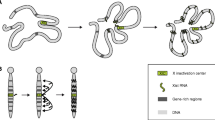Abstract.
Recent years have seen rapid progress towards understanding the molecular mechanisms involved in X chromosome inactivation (X inactivation). This progress has largely revolved around the discovery of the X inactive specific transcript (Xist) gene, which is known now to represent the master switch locus regulating X inactivation. In adult cells Xist is transcribed exclusively from the inactive X chromosome. The transcript has no apparent protein-coding potential and is retained in the nucleus in close association with the domain occupied by the inactive X chromosome. It is thus thought to represent a functional RNA molecule which acts as the primary signal responsible for the propagation of X inactivation. Developmental regulation of Xist correlates with the developmental timing of X inactivation. Recent results have demonstrated that Xist is both necessary and sufficient for X inactivation. Goals for the future are to understand the mechanism of Xist regulation which underlies the establishment of appropriate X inactivation patterns and to determine how Xist RNA participates in the process of propagating inactivation in cis.
Similar content being viewed by others
Author information
Authors and Affiliations
Rights and permissions
About this article
Cite this article
Brockdorff, N., Duthie, S. X chromosome inactivation and the Xist gene. CMLS, Cell. Mol. Life Sci. 54, 104–112 (1998). https://doi.org/10.1007/s000180050129
Issue Date:
DOI: https://doi.org/10.1007/s000180050129




